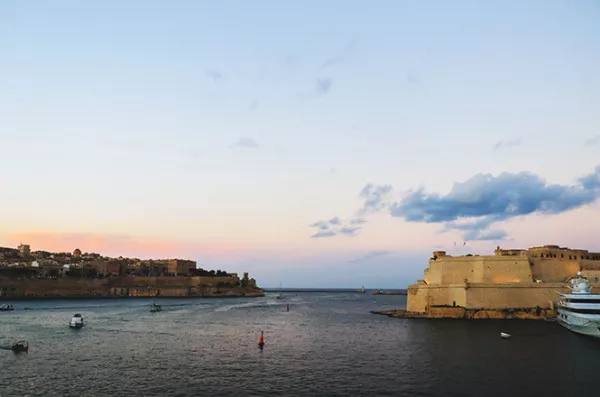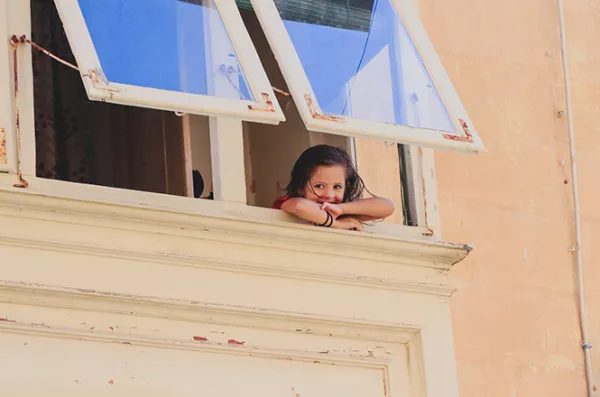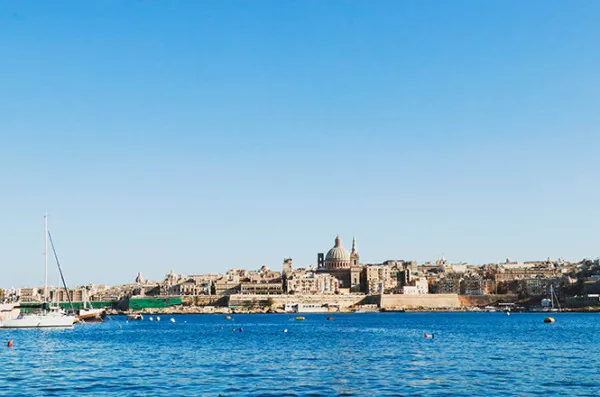On our third day in Malta, we encountered the annual sleepless night in Valletta.

(Road sign for sleepless nights in Valletta)
It's a sleepless night, but for this small town that rests early at night, it's already the liveliest night of the year: the streets and alleys are lined with lights; stages are set up in the square, with singers and bands taking turns on stage; restaurants and bars extend their hours and bring their tables and food outside; churches and museums are free to visit until late at night.

(sleepless night before the streets)
It was 6 p.m. when we returned to Valletta, and although the sleepless night began at 7 p.m., people throughout the city were already jumping into action. The streets were filling up and we made our way through the crowds to find seats in the open-air restaurant in front of St. Peter's Church, where the children of the choir were standing on the steps of the church rehearsing, their clear voices singing across the square. By the time the choral performance began, the area around the church was already crowded with people, and there were lights coming down from high above, enveloping the area, while the children sang cheerful songs under the lights, and the innocent atmosphere affected the surroundings, and despite the language barrier, the onlookers hummed along to the simple, light melodies. The darkness was like flowing water, but the lights of the small town were like starlight falling into the flowing water, and there was a warmth and power in the songs.
Until then, we never knew there was such a festival. The only reason we were back so early that afternoon was because we had taken a bus in the opposite direction at Dingley Cliffs, which threw off our plans to go to the Blue Hole. It's not easy to get a bus on time in Malta, and even if you get the right one, you may have to fly off because the driver thinks it's full or is just in a bad mood, so you really have to be patient when travelling in Malta.

(Super easy bus stop at Dingley Cliffs)
We've missed an hourly bus in Old Town Mdina because we were careless and chased it, shouting after it to no avail; we've waited for an hour in the sunlight under the bus stop at the entrance to the Blue Hole, watching the bus driver turn around and speed away; we've panted and panted to catch a bus only to have the driver wave his hand and tell us to Fullsorry. We have also panted to catch the bus only to be told by the driver to get off and wait.
Although we had heard a little about public transport in Malta before we left, our experience was different from what we had heard. At first, the unreliability of public transport was a real pain in the ass, as our daily schedule was easily disrupted, sometimes leaving in the morning light and wandering around for hours to get to one place, while some destinations were already sunset before we even left. However, we gradually settled into this rhythm, leaving behind the rush we had at home and slowly settling into the lazy Maltese daylight.
The decision to go to Malta was initially made because of the famous Siege of Malta, in 1530 the Order of the Hospital moved to Malta as a stronghold after the defeat of Rhodes, with the promise of King Charles V of Spain, and this Mediterranean island, 35.53 degrees north latitude and 14.31 degrees east longitude, has been a place of contention for soldiers since ancient times due to its important geographical location. 1565. Ottoman Empire sent an army to Malta to seize it and fought a bitter four-month war against the Knights on the main island of Malta, before being defeated and sent home.
The victory of the siege was of great significance for the whole of Europe, as the Ottomans were gaining momentum and their westward expansion was causing panic throughout the Christian lands, and the stubborn resistance of Malta saved the Christian coast from a great catastrophe.

(Triangle Fort at sunset)
It was a high noon on the day of arrival in Malta. The former siege centre, the Triangular Fortress of Valletta, has long since become less of a fortress of solitude than the book suggests. As we stepped off the bus with our luggage, the fort stood on the other side of the sea like a weather-beaten but still beautifully quiet teenager, while the harbour of Marsamxett was pure blue, with daylight spilling over the sea like fine gold leaf, and all sorts of private boats docking there, as if there had never been a war.
We spent four days and three nights here, wandering the streets and alleys of Valletta, seeing the sunset almost every night at sunset. People live side-by-side in houses of up to three stories, but the windows and doors and nameplates are so colorful and varied that sometimes when we walk down the street we meet little girls who have just washed their hair and are lying on their white balconies on the second floor, shyly greeting us.

(little girl lying on the second floor balcony saying hello to us)
Before I left, I thought that this small Mediterranean country would be full of history and people have experienced many wars, from the Ottoman invasion in the Middle Ages to the bombs dropped by the German army during World War II, which made this country with a land area of 316 square kilometers full of holes. If they can survive the hardship and despair, they can also live their lives like poetry afterwards.
It was like the life of sitting in the sun on the beach reading the newspaper during the day, or riding the ferry home from Valletta at sunset, or sitting in front of the church listening to children singing nursery rhymes on sleepless nights.
It's probably the only place where you can truly appreciate that life is not elsewhere, it's right here.

(Port of Massachusetts Harbor in the morning light)